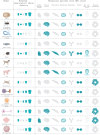Disease models of Leigh syndrome: From yeast to organoids
- PMID: 39385390
- PMCID: PMC11586605
- DOI: 10.1002/jimd.12804
Disease models of Leigh syndrome: From yeast to organoids
Abstract
Leigh syndrome (LS) is a severe mitochondrial disease that results from mutations in the nuclear or mitochondrial DNA that impairs cellular respiration and ATP production. Mutations in more than 100 genes have been demonstrated to cause LS. The disease most commonly affects brain development and function, resulting in cognitive and motor impairment. The underlying pathogenesis is challenging to ascertain due to the diverse range of symptoms exhibited by affected individuals and the variability in prognosis. To understand the disease mechanisms of different LS-causing mutations and to find a suitable treatment, several different model systems have been developed over the last 30 years. This review summarizes the established disease models of LS and their key findings. Smaller organisms such as yeast have been used to study the biochemical properties of causative mutations. Drosophila melanogaster, Danio rerio, and Caenorhabditis elegans have been used to dissect the pathophysiology of the neurological and motor symptoms of LS. Mammalian models, including the widely used Ndufs4 knockout mouse model of complex I deficiency, have been used to study the developmental, cognitive, and motor functions associated with the disease. Finally, cellular models of LS range from immortalized cell lines and trans-mitochondrial cybrids to more recent model systems such as patient-derived induced pluripotent stem cells (iPSCs). In particular, iPSCs now allow studying the effects of LS mutations in specialized human cells, including neurons, cardiomyocytes, and even three-dimensional organoids. These latter models open the possibility of developing high-throughput drug screens and personalized treatments based on defined disease characteristics captured in the context of a defined cell type. By analyzing all these different model systems, this review aims to provide an overview of past and present means to elucidate the complex pathology of LS. We conclude that each approach is valid for answering specific research questions regarding LS, and that their complementary use could be instrumental in finding treatment solutions for this severe and currently untreatable disease.
Keywords: Leigh syndrome; animal models; disease modeling; mitochondrial diseases; organoids; phenotyping; pluripotent stem cells.
© 2024 The Author(s). Journal of Inherited Metabolic Disease published by John Wiley & Sons Ltd on behalf of SSIEM.
Conflict of interest statement
Marie‐Thérèse Henke declares that she has no conflict of interest. Alessandro Prigione declares that he has no conflict of interest. Markus Schuelke declares that he has no conflict of interest. Alessandro Prigione and Markus Schuelke have submitted patent applications for the use of Sildenafil in Leigh syndrome. Alessandro Prigione has submitted patent applications for the use of Talarozole and Sertaconazole in Leigh syndrome.
Figures

References
Publication types
MeSH terms
Substances
Grants and funding
- 101080249/HORIZON EUROPE European Research Council
- PR1527/6-1/DFG (Deutsche Forschungsgemeinschaft)
- 01GM2002A/European Joint Programme for Rare Diseases (EJPRD) supported in Germany by the BMBF (Bundesministerium für Bildung und Forschung)
- Foundations MitoHelp, CureMito, and CureATP6
- Fondation Maladies Rares
LinkOut - more resources
Full Text Sources
Molecular Biology Databases
Miscellaneous

